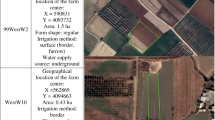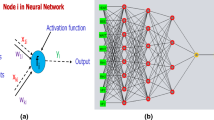Abstract
Neural network is one among the foremost powerful predictive analytics techniques. This paper considers a wide range of neural network topologies, followed by an examination of how to optimize and analyze neural networks using agriculture data. A back-propagation model was proposed here to create a predictive inference model, with five hidden layers and activation function as sigmoid. Four Kaggle datasets are used here to assess the ability of the proposed neural network approach regarding prediction, and three datasets are gathered from Kerala Agriculture University in real time. Finally, as an optimization strategy, adaptive momentum estimation was utilized, and the applied findings demonstrate that Adam optimizer achieves good prediction accuracy, and F1 score with the help of neuro-fuzzy system and therefore better convergence rate. The proposed method enables more precise control of the direction and step size for updating weight vectors, leading to significantly improved generalization performance. Experimental results reveal that the proposed method shows an accuracy of 97% in average. The suggested approach outperforms other benchmark algorithms such as C4.5, ID3, CART, Naïve Bayes, fuzzy, MLP and hence it can be concluded that the proposed hybridization of back-propagation neural networks with adaptive optimization method clearly verifies the efficiency of Adam optimizer with back propagation for text data.












Similar content being viewed by others
Data Availability
Enquiries about data availability should be directed to the authors.
References
Aboagye-Sarfo P, Mai Q, Sanfilippo FM, Preen DB, Stewart LM, Fatovich DM (2015) A comparison of multivariate and univariate time series approaches to modelling and forecasting emergency department demand in Western Australia. J Biomed Inform 57:62–73
Abu-Naser, S.S., Zaqout, I.S., Abu Ghosh, M., Atallah, R.R. and Alajrami, E., 2015. Predicting student performance using artificial neural network: In the faculty of engineering and information technology.
Allen TT, Sui Z, Parker NL (2017) Timely decision analysis enabled by efficient social media modeling. Decis Anal 14(4):250–260
Allen TT, Sui Z, Akbari K (2018) Exploratory text data analysis for quality hypothesis generation. Qual Eng 30(4):701–712
Andreani R, Martinez JM, Santos LT (2016) Newton’s method may fail to recognize proximity to optimal points in constrained optimization. Math. Program. 160(1–2):547–555
Benardos AG, Kaliampakos DC (2004) A methodology for assessing geotechnical hazards for TBM tunnelling—illustrated by the Athens Metro, Greece. Int J Rock Mech Min Sci 41(6):987–999
Çolak AB (2021) An experimental study on the comparative analysis of the effect of the number of data on the error rates of artificial neural networks. Int J Energy Res 45(1):478–500
Deenadayalan D, Kangaiammal A. and Poornima BK (2019) Learner Level and Preference Prediction of E-learners for E-learning Recommender Systems. In: Integrated Intelligent Computing, Communication and Security (pp. 133–139). Springer, Singapore
Gopakumar G, Hari Babu K, Deepak Mishra, Sai Siva Gorthi, and Gorthi RK, Sai Subrahmanyam (2017) Cytopathological image analysis using deep-learning networks in microfluidic microscopy. J Opt Soc Am A. 34 111–121
Heaton J (2016) An empirical analysis of feature engineering for predictive modeling. SoutheastCon 2016:1–6
Huang C, Lin W, Lai C, Li X, Jin Y, Yong Q (2019) Coupling the post-extraction process to remove residual lignin and alter the recalcitrant structures for improving the enzymatic digestibility of acid-pretreated bamboo residues. Bioresour. Technol. 285:121355
Huang C et al (2019) A sustainable process for procuring biologically active fractions of high-purity xylooligosaccharides and water-soluble lignin from Moso bamboo prehydrolyzate. Biotechnol Biofuels 12(1):189
Karaboga D, Kaya E (2016) An adaptive and hybrid artificial bee colony algorithm (aABC) for ANFIS training. Appl Soft Comput 49:423–436
Khan S, Yairi T (2018) A review on the application of deep learning in system health management. Mech Syst Signal Process 107:241–265
Kingma DP, Ba J. Adam (2014) A method for stochastic optimization. arXiv preprint arXiv:1412.6980
Kingma DP and J. Ba, “Adam: A method for stochastic optimization,” arXiv Prepr. arXiv1412.6980, 2014.
Li Y and Yuan Y (2017) Convergence analysis of two-layer neural networks with relu activation. In|: Advances in Neural Information Processing Systems, pp. 597–607
Liu C, Hu Z, Li Y, Liu S (2017) Forecasting copper prices by decision tree learning. Resour Policy 52:427–434
Lydia A and Francis FS (2019) Adagrad-An Optimizer for Stochastic Gradient Descent
Maclaurin D, Duvenaud D, and Adams R (2015) Gradient-based hyperparameter optimization through reversible learning. In: International Conference on Machine Learning, pp. 2113–2122
Miikkulainen R et al. (2019) Evolving deep neural networks. In: Artificial Intelligence in the Age of Neural Networks and Brain Computing, Elsevier, pp. 293–312
Nair DP, John AM, Varshini EA, Arunima D. and Gopakumar G (2021) Performance analysis of deep learning architectures for super resolution. In: Journal of Physics: Conference Series. 1917(1) 012002. IOP Publishing.
Nair JJ, Thomas S (2017) Improvised apriori with frequent subgraph tree for extracting frequent subgraphs. J Intell & Fuzzy Syst. 32(4):3209–3219
Nguyen TH, Nong D, Paustian K (2019) Surrogate-based multi-objective optimization of management options for agricultural landscapes using artificial neural networks. Ecol Model 400:1–13
Peerlinck A, Sheppard J, and Senecal J (2019) AdaBoost with Neural Networks for Yield and Protein Prediction in Precision Agriculture. Proc. Int. Jt. Conf. Neural Networks. 2019 1–8
Rawat W, Wang Z (2017) Deep convolutional neural networks for image classification: a comprehensive review. Neural Comput 29(9):2352–2449
Remya S, Sasikala R (2019) Classification of rubberized coir fibres using deep learning-based neural fuzzy decision tree approach. Soft Comput 23(18):8471–8485
Roy A and Todorovic S (2018) Learning to Learn Second-Order Back-Propagation for CNNs Using LSTMs. In: 2018 24th International Conference on Pattern Recognition (ICPR), pp. 97–102
Ruder S (2016) An overview of gradient descent optimization algorithms arXiv Prepr. arXiv1609.04747, 2016
Saba T, Rehman A, AlGhamdi JS (2017) Weather forecasting based on hybrid neural model. Appl Water Sci 7(7):3869–3874
Salem H, Kabeel AE, El-Said EM, Elzeki OM (2022) Predictive modelling for solar power-driven hybrid desalination system using artificial neural network regression with Adam optimization. Desalination. 15(522):115411
Shahnazar A, Rad HN, Hasanipanah M, Tahir MM, Armaghani DJ, Ghoroqi M (2017) A new developed approach for the prediction of ground vibration using a hybrid PSO-optimized ANFIS-based model. Environm Earth Sci. 76(15):1–17
Shakya S, Smys S (2020) Reliable automated software testing through hybrid optimization algorithm. J Ubiquitous Comput Commun Technol (UCCT) 2(03):126–135
Shi B, Bai X, Yao C (2016) An end-to-end trainable neural network for image-based sequence recognition and its application to scene text recognition. IEEE Trans Pattern Anal Mach Intell 39(11):2298–2304
Smith SL and V Le Q (2017) A bayesian perspective on generalization and stochastic gradient descent arXiv Prepr. arXiv1710.06451
Sungheetha A, Sharma R (2021) Fuzzy chaos whale optimization and BAT integrated algorithm for parameter estimation in sewage treatment. J Soft Comp Paradigm (JSCP) 3(01):10–18
Walczak S (2016) Artificial neural networks and other AI applications for business management decision support. Int J Soc Technol Knowl Dev 8(4):1–20
Weiss S et al (2016) Correlation detection strategies in microbial data sets vary widely in sensitivity and precision. ISME J 10(7):1669
Ye, Jong Chul (2022) Artificial Neural Networks and Backpropagation. Geometry of Deep Learning. Springer, Singapore. 91–112
Zhu B and Chevallier J (2017) Carbon price forecasting with a hybrid Arima and least squares support vector machines methodology. In: Pricing and Forecasting Carbon Markets, Springer, 2017, pp. 87–107
Funding
The authors have not disclosed any funding.
Author information
Authors and Affiliations
Corresponding author
Ethics declarations
Conflict of Interest
The authors have not disclosed any competing interests.
Additional information
Publisher's Note
Springer Nature remains neutral with regard to jurisdictional claims in published maps and institutional affiliations.
Rights and permissions
About this article
Cite this article
Remya, S. An adaptive neuro-fuzzy inference system to monitor and manage the soil quality to improve sustainable farming in agriculture. Soft Comput 26, 13119–13132 (2022). https://doi.org/10.1007/s00500-022-06832-3
Accepted:
Published:
Issue Date:
DOI: https://doi.org/10.1007/s00500-022-06832-3




